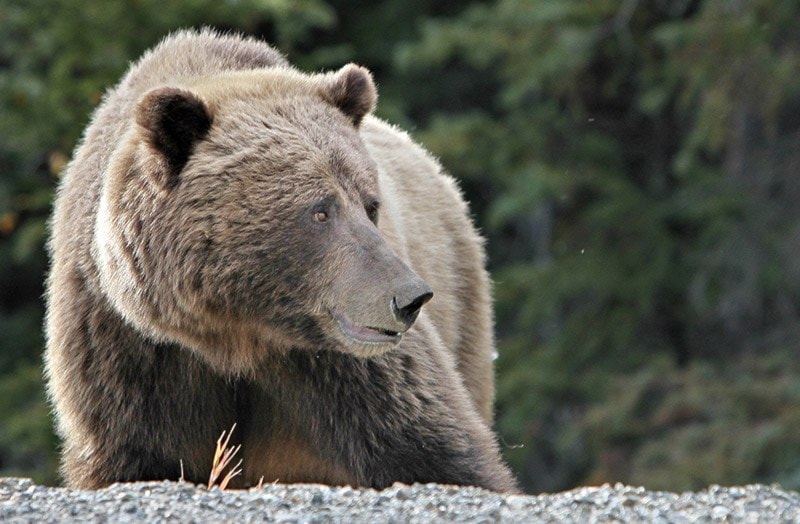When Ramona Maraj’s pager goes off at 1 a.m., it’s usually a grizzly bear calling.
Maraj is Yukon’s carnivore biologist, and her pager buzzes when one of her traps is tripped.
She’s conducting the first major study of how many grizzlies live in the Southern Lakes region, which is framed by the BC border to the south, the Alaska Highway to the east and north, and Kusawa Lake to the west.
It’s an important question for the territory’s wildlife managers, because without knowing the size and health of the grizzly population, it’s impossible to effectively regulate the grizzly hunt.
And grizzly bears, along with other big animals such as moose, face a growing threat in southern Yukon.
It’s us.
Housing and roads have eaten into grizzly habitat. And what wilderness remains may now be easily accessed by hunters, thanks to the growing popularity of all-terrain vehicles.
Remote valleys and alpine meadows that once took several days to reach by horse may now be accessed within a few hours from Whitehorse.
Typically, residents of the Southern Lakes region report the deaths of two grizzly sows annually. That’s “quite high” for the population density found in the area, said Maraj.
Population estimates from the 1980s put the Southern Lakes grizzly population at about 90.
Resident hunters are able to shoot one grizzly every three years. There’s no total allowable harvest for grizzlies.
The last time outfitters hunted grizzlies in the Southern Lakes area was in the late 1990s or early 2000s, said conservation officer Ryan Hennings.
Maraj’s study should take at least five years, and her first season’s work is just about wrapped up, as bears are currently digging their winter dens.
She’s gotten off to a slow start. She hoped to capture 40 grizzlies to fit with radio-transmitting collars, which allow Maraj to later track the bears’ movements during helicopter surveys.
She’s gotten eight so far. Three are females, which are the ones that matter if you’re interested in calculating a population’s birth rate, as Maraj is.
She catches bears with a variety of traps. Some use padded snares concealed in long plastic tubes. Others lure bears into metal cages or culverts. All are designed to ensure the bear stays put, without harming the animal.
To entice grizzlies, the traps are baited with fermented seal meat, which Maraj attests is “definitely smelly.”
Unfortunately, the bait attracts more than grizzlies.
Maraj has been more successful in catching black bears - which are more populous and resilient than grizzlies, and so are not as big of a conservation concern.
When a trap is tripped, a signal bounces from it up to a satellite and back down to a phone service, which buzzes Maraj’s pager.
Once Maraj finds a captured bear, she and her technician, Molly Kirk, sedate the animal, give it a battery of tests and fit it with a radio collar.
They rig up a metal tripod to weigh the animal. They pull a tooth, which can be used to tell how old a bear is.
They take hair samples and a plug of fat, which can both indicate the animal’s diet. And she collects a blood sample to determine the animal’s health.
It all takes about an hour.
All this work is intrusive, but necessary, if we’re to gather the best possible information with which to manage the grizzly population, said Maraj.
To understand how the grizzly population is faring in Southern Lakes, she needs to know a lot more than the number of bears.
She also needs to establish the grizzly’s birth and death rates, as well as their range and movements.
Grizzlies that decline in one area may be replaced by bears from elsewhere that move in to fill the vacuum. Unless those movements are understood, the decline may go unnoticed.
And grizzlies can cover a lot of ground. It’s not uncommon for males to cover 70 kilometres in a day. “They definitely truck from place to place,” said Maraj.
Maraj also captured several grizzlies without traps, by darting the animals during her periodic helicopter surveys. She could have caught more, but on a few occasions she decided against darting sows with young cubs.
“I thought, ‘That cub’s too young,’” she said.
The bear’s breathing and pulse is carefully monitored while it’s tranquilized. Nevertheless, a bear will occasionally react badly to the powerful drugs and die.
None died under Maraj’s watch this summer.
But, once collared and released, a bear is occasionally shot, such as a boar that ventured up a driveway along Annie Lake Road this summer.
The death of every collared bear is a setback for Maraj’s research, which is why the territorial government is urging hunters to not shoot collared animals.
There’s only one other extensive study of a grizzly population that’s been undertaken in the Yukon, on the territory’s North Slope. That study began in 2004 and should wrap up next year.
The Southern Lakes project costs about $150,000 annually. Like so much else having to do with the project, its end date will not be determined by Maraj, but by the bears she studies.
“They run my life,” she said. “They manage me.”
Contact John Thompson at
johnt@yukon-news.com.
